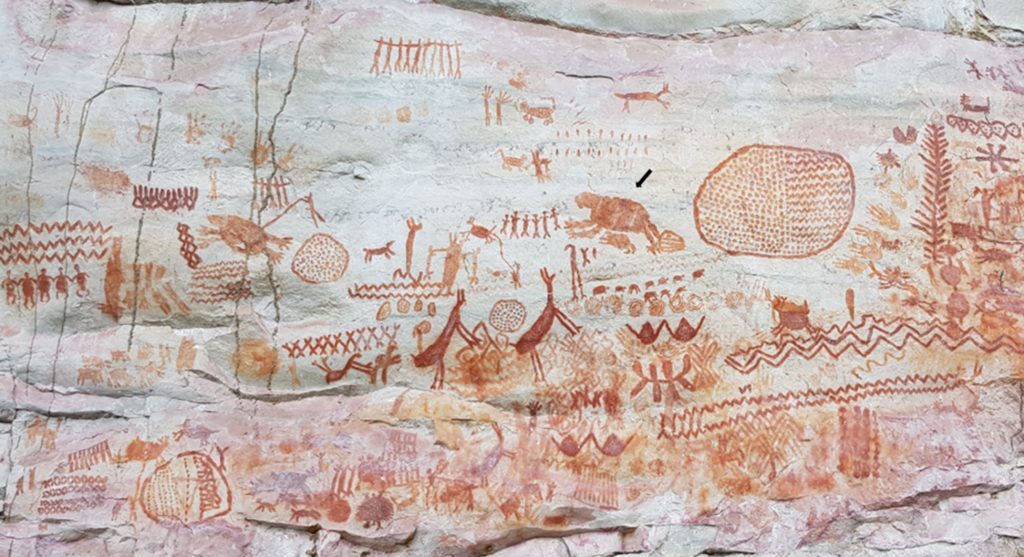
© José IriarteLas Dantas panel at Cerro Azul, La Lindosa (arrow points to proposed giant sloth painting).
from the Amazon, hailed by some as "the Sistine Chapel of the ancients," may depict extinct Ice Age mammals, offering a fascinating snapshot of doomed species and their brief coexistence with humankind.
The eight-mile Cerro Azul rock art mural at Serranía de la Lindosa in Colombia's Guaviare region, on the banks of the Guayabero River, has been the subject of recent expeditions led by José Iriarte, an archaeologist at the University of Exeter. Now, the ocher paintings have become the subject of debate, as experts attempt to definitively date them and identify the animals.
It's possible that the stunning artworks are up to 12,000 years old, and show Ice Age megafauna, as argued by a study published this week in the journal
Philosophical Transactions of the Royal Society B. (Archaeologists first began studying the paintings in 2016, after a peace treaty brought stability to the region after years of civil war, and
published their initial findings in late 2020).
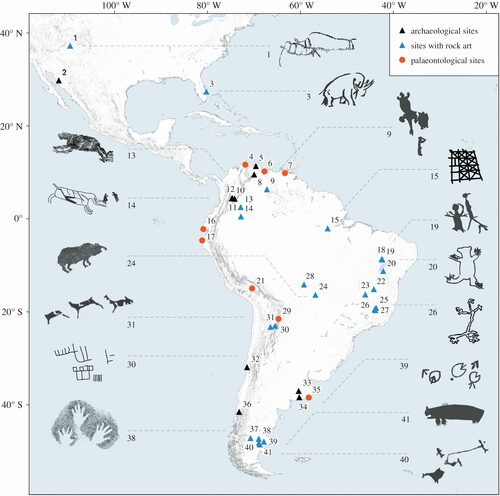
Figure 1. Map of the Americas showing most important LP-EH archaeological, rock and portable art, and palaeontological sites mentioned in the text where Ice Age megafauna has been documented or portrayed: 1. Upper Sand Island site; 2. Fin del Mundo; 3. Vero Beach; 4. Ware Formation; 5. Taima-Taima; 6. Lake Valencia; 7. El Breal de Orocual; 8. El Vano; 9. Cerro Gavilán; 10. Totumo; 11. Pubenza; 12. Tibitó; 13. Serranía la Lindosa; 14. Chiribiquete; 15. Caverna da Pedra Pintada; 16. Tanque Loma; 17. Talara; 18. Serra da Capivara; 19. Toca da Bastiana; 20. Bahia; 21. Casa del Diablo; 22. Lapa do Boquete; 23. Lapa do Gentio; 24. Santa Elina; 25. Santana do Riacho; 26. Lapa do Santo; 27. Lagoa Santa region; 28. Abrigo do Sol; 29. Tarija; 30. Inca Cueva; 31. Hornillos 2; 32. Los Vilos; 33. Campo Laborde; 34. Arroyo Seco 2; 35. Centinela del Mar; 36. Monte Verde; 37. Cueva de las Manos; 38. Los Toldos; 39. Piedra Museo; 40. Cerro Tres Tetas; 41. El Ceibo. (
Iriarte, the study's lead author, told
CNN. He believes that as prehistoric humans migrated down into South America, "they encountered these large-bodied mammals and they likely painted them. And while we don't have the last word,
these paintings are very naturalistic and we're able to see morphological features of the animals."
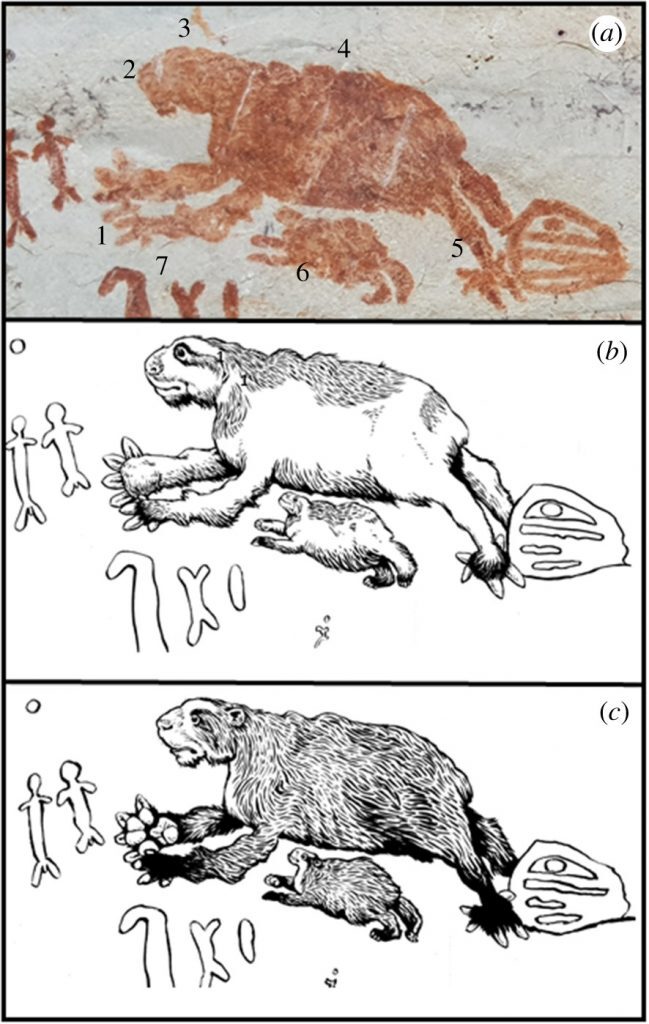
© José IriartePart of an eight-mile rock art mural at Serranía de la Lindosa in Colombiam this image may depict an extinct giant ground sloth and its offspring. Drawings by Mike Keesey offer artistic reconstructions patterned after a close living relative, the three-toed sloth, center, and an extinct bear species, Arctotherium, bottom.
As the last ice age drew to a close, South America would have been home to creatures that would look exotic to modern eyes, including
giant ground sloths, elephant-like creatures called gomphotheres, extinct Pleistocene horses, and hoofed mammals from the Litopterna family.
In the paintings at Serranía de la Lindosa,
Iriarte points to a larger animal trailed by a smaller one, which he believes is the adult giant ground sloth and its offspring.But Iriarte's findings are not universally accepted — interpreting art, after all, is always subjective.
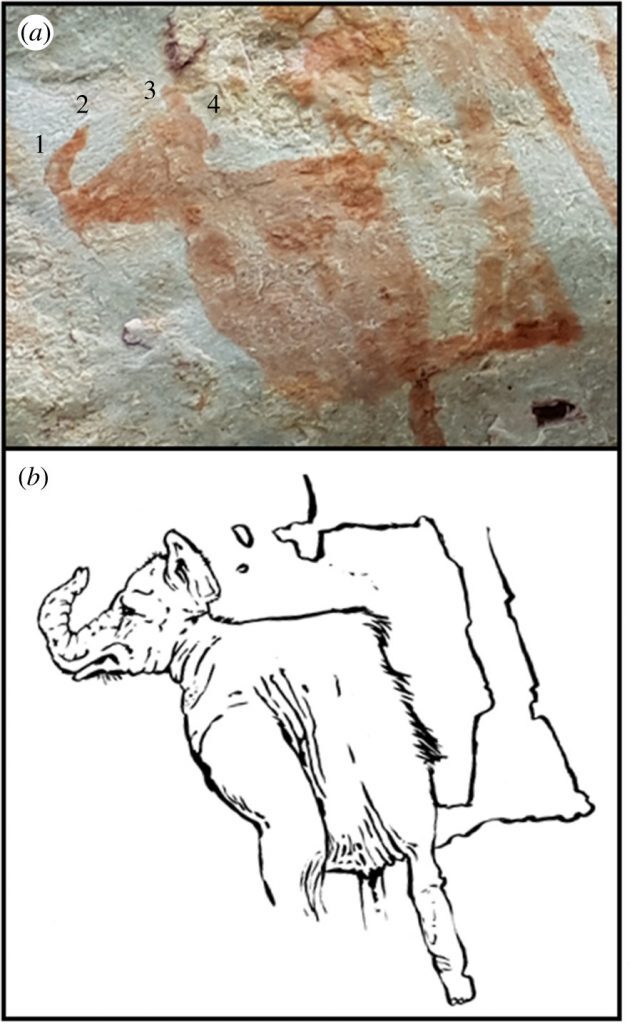
© José IriartePart of an eight-mile rock art mural at Serranía de la Lindosa in Colombia, this image may depict an extinct relative of the elephant known as the Gomphothere. A drawing by Mike Keesey offers an artistic reconstruction of the following features: 1. proboscis; 2. fingers; 3. flared ears?; 4. moderately domed head.
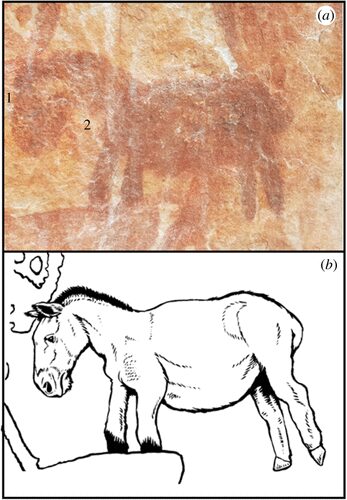
© Mike KeeseyFigure 5. (a) Horse painting at La Lindosa: 1. large head; 2. robust neck. (b) Artistic reconstruction of Hippidion patterned after wild Equus ().
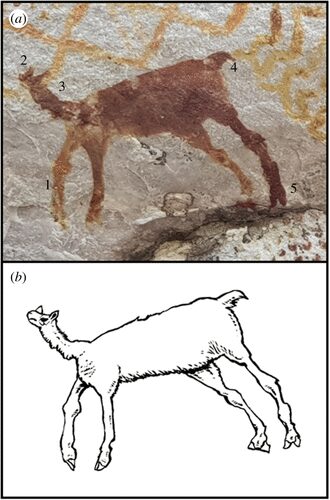
© Mike KeeseyFigure 6. (a) Camelid painting at La Lindosa: 1. front legs smaller than rear legs; 2. small head; 3. long thin neck; 4. ‘camelid' tail; 5. two toes. (b) Artistic reconstruction of Palaeolama
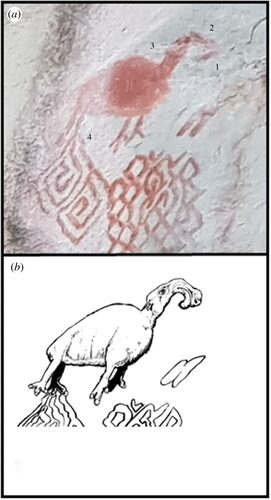
© Mike KeeseyFigure 7. (a) Macraucheniid paintings at La Lindosa: 1. proboscis; 2. elongated rostrum; 3. defined neck; 4. three digits on each foot. (b) Artistic reconstruction of macraucheniids
Definitively identifying the figures as extinct megafauna is "wishful thinking" based solely on "eyeballing," Ekkehart Malotki, a Northern Arizona University professor emeritus who has published similar research about ancient petroglyphs, told the
New York Times.
There is also still a question of how old the paintings are, especially considering how extraordinarily well-preserved they are, despite exposure to the elements.
Since 2016, Fernando Urbina and Jorge Peña, archaeologists at the Universidad Nacional de Colombia, have argued that the murals might be only a few hundred years old. That would mean they have nothing to do with the Ice Age, and that the mammals in the paintings might be present-day animals, such as capybaras or modern horses introduced by Europeans.
Archaeologists are hoping that testing will provide more definitive dating for the paintings later this year. Those findings should prove instrumental in resolving the debate once and for all.










12000+ years in a steamy jungle yet they look like they were drawn last summer.
seems like an attempt to creatively increase tourism to the region.
we look forward to reading the chemical analysis of the pigment ... always wondered what Sharpie marker ink is made from : )